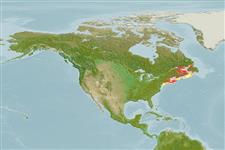>
Gadiformes (Cods) >
Gadidae (Cods and haddocks)
Etymology: Microgadus: Greek, mikros = samll + Latin, gadus = a fish, cod? (Ref. 45335).
More on author: Walbaum.
Environment: milieu / climate zone / depth range / distribution range
Écologie
marin; eau douce; saumâtre démersal; anadrome (Ref. 26213); profondeur 0 - 69 m (Ref. 57178). Temperate; 54°N - 36°N, 76°W - 56°W (Ref. 86798)
Northwest Atlantic: southern Labrador in Canada to Virginia in USA.
Taille / Poids / Âge
Maturity: Lm ? range ? - ? cm
Max length : 38.1 cm TL mâle / non sexé; (Ref. 5951)
Épines dorsales (Total) : 0; Épines anales: 0. Body elongated; head small; eyes relatively small. Pelvic fins with a slightly elongated filament. Olive green brown or yellow dorsally, paler ventrally; with dark mottling on sides and fins.
Found in coastal, brackish and fresh water, landlocked in several lakes. Feeds mostly on small crustaceans, (especially shrimps and amphipods); also worms, small mollusks, squids and fishes (smelt, sticklebacks, striped bass, alewives, shed, herring and sculpins (Ref. 5951)) (Ref. 1371).
Life cycle and mating behavior
Maturité | Reproduction | Frai | Œufs | Fécondité | Larves
Oviparous, sexes are separate (Ref. 205).
Cohen, D.M., T. Inada, T. Iwamoto and N. Scialabba, 1990. FAO species catalogue. Vol. 10. Gadiform fishes of the world (Order Gadiformes). An annotated and illustrated catalogue of cods, hakes, grenadiers and other gadiform fishes known to date. FAO Fish. Synop. 125(10). Rome: FAO. 442 p. (Ref. 1371)
Statut dans la liste rouge de l'IUCN (Ref. 130435: Version 2024-2)
Menace pour l'homme
Harmless
Utilisations par l'homme
Pêcheries: intérêt commercial mineur; pêche sportive: oui
Outils
Articles particuliers
Télécharger en XML
Sources Internet
Estimates based on models
Preferred temperature (Ref.
123201): 2.7 - 12.6, mean 6.4 °C (based on 144 cells).
Phylogenetic diversity index (Ref.
82804): PD
50 = 0.7500 [Uniqueness, from 0.5 = low to 2.0 = high].
Bayesian length-weight: a=0.00398 (0.00190 - 0.00835), b=3.13 (2.95 - 3.31), in cm total length, based on LWR estimates for this (Sub)family-body shape (Ref.
93245).
Niveau trophique (Ref.
69278): 3.8 ±0.50 se; based on food items.
Résilience (Ref.
120179): Milieu, temps minimum de doublement de population : 1,4 à 4,4 années (Assuming tm=2-4).
Fishing Vulnerability (Ref.
59153): Low to moderate vulnerability (28 of 100).
Climate Vulnerability (Ref.
125649): High to very high vulnerability (75 of 100).
Nutrients (Ref.
124155): Calcium = 48 [26, 98] mg/100g; Iron = 0.354 [0.195, 0.622] mg/100g; Protein = 17.7 [16.4, 19.1] %; Omega3 = 0.414 [0.202, 0.847] g/100g; Selenium = 11.7 [5.8, 26.8] μg/100g; VitaminA = 13.4 [3.7, 47.0] μg/100g; Zinc = 0.656 [0.458, 0.956] mg/100g (wet weight);
